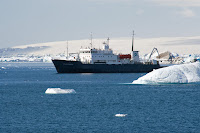The White Continent
When we boarded the Polar Pioneer that Friday afternoon. She was dwarfed by the Hurtigruten vessel docked opposite to her. We were shown our cabin on the level just below the bridge with a nice square porthole, only to be reminded later, that the higher you are on any ship, the more you will feel the sway.
Our little group on board consisted of 45 expeditioners (or us the paying people), accompanied by 22 Russian crew and 10 mostly Australian expedition staff.
Our first exercise on board was to crawl into one of two life boats, one of those fully enclosed vessels that can roll 360 degrees around in stormy seas, during which the claustrophobic among us are dying a worse death than being thrown into the icy waters.

Although
, after "dying", they could later look back "alive" at the psychotic experience of being buried for, god only knows how many hours, clothed in whatever they would have been in at the time the sirens sounded, over which a full life vest was thrown, together in a cramped space with 38 others in that sarcophagus but lived to tell about it. This to me seems better than drowning. The test photo here shows only us, that is 28 people without the Russian crew, and that was already very cozy. After that most of us roamed the ship, to reconnoiter it on a sunny late afternoon from bridge to bow to aft and below, finding spaces like the dining room and the lecture room. There was even a sauna, although I never visited it, so I can't tell if it was ever used.
Late that night after our first family type dinner, which we would become very familiar with in the days to come, we started the crossing of the dreaded Drake Passage, which turned out to be, that specific night and the following day, a smooth water surface, often called "Drake Lake".
It did however not prevent me and a few uncounted others from being seasick the following night, requiring an injection in my butt from our Australian lady doctor, who later turned out to be a very experienced zodiac driver.
The Drake Passage is famous for its collision of currents, which creates a sway below the surface, making you feel, like you are part of a turbulence in your innards, whereby some parts of you go left, others right and some up and down.
When the Drake is at its best, showing waves of 20 foot or more, then supposedly all hell brakes loose in your body. I will spare you the stories about boot distributions, what we ate at dinner lunch or breakfast, and most of the lecture content we received during this voyage.
If any detail knowledge will be written down in the following 2 blogs, they may have been gleamed by me during those lectures and presented to you as the result of my own research. So bite me for the lack of reference notes on the bottom of my blogs.
Albatrosses were drifting gracefully behind the ship, as well as petrels. These bird names are here for those that expect me to mention them as part of my aviary knowledge of birds that seem to live in this environment.
It was Monday morning early, when we had our first encounter with zodiacs and penguins on a little beach below Brown Bluff, as the rocky outcrop we sighted from our ship was called. Our 12 kayakers went to the aft, from where they "board" their 2 person canoes and the rest of us went down the gangway to experience our first "step in the zodiac" moment (for some of us a "Kodak moment").

Adelies and Gentoos welcomed us, especially the chicks to whom we are a new specimen to be sniffed at.
It is an exciting and a really not easy to explain moment, when one steps on land on this 7th continent inhabited only by animals and a few visiting researchers and meet quite a few of its residents within a few feet from you. Further down the beach we even met a seal,
who huffed and puffed at us, when we did not leave him alone, with that clicking sound of cameras or maybe because we were too close, so from a sleeping position he, or was it a she, raised himself and stared at us making threatening sounds, resulting in a nice picture.
We entered the Weddell sea to see how far we could go between the amassed ice and the even more foreboding iceberg formations. All around us was water and ice. Besides large icebergs we found a lot of brash ice, the smallest form of drift ice and quite some bergy bits or small ice clumps large enough to stand on and too small to be called bergs. This also became our first encounter with silence and all around whiteness. By the way ice in its coldest and most compact form is blue, real deep blue.
The captain went further in than ever before in his career in this specific sea. And we were in awe and also silenced by all that white around us. During the rest of our trip we met very few other vessels.
We also ventured further south than most cruise and expedition ships and became therefore polar circle club members, of which to date less than 20,000 supposedly are alive (that might be because many of them died a few years later of old age, although our group was not that old in average). After our first encounter with penguins and a little cruising through the brash ice and around some bergy bits we climbed on board again to continue deeper into iceberg country as only an ice breaker can.
The next blogs will discuss the animals and the land formations as well as the scientific research stations we visited.
























Comments
Post a Comment